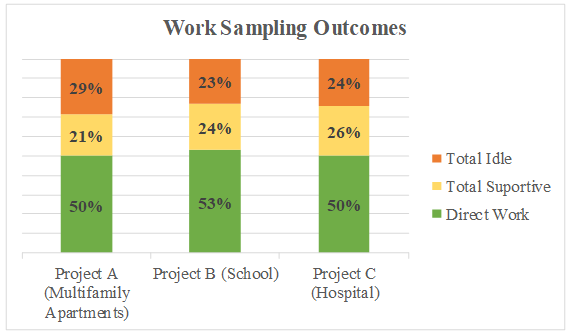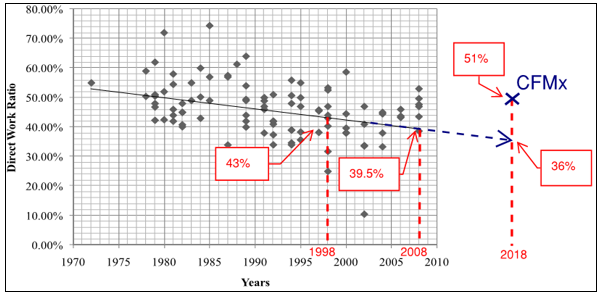Case Study
Measuring the Effectiveness of Clear Flow Matrix
Situation
Construction projects are scheduled and managed using a variety of techniques, most notably CPM (originated in the sixties).
Outcome
A Work Sampling Analysis conducted at UT in 2018 found Clear Flow Matrix to be a superior alternative.
In 2018, research conducted by the University of Texas at Austin by using Work Sampling Analysis demonstrated the effectiveness of the Clear Flow Matrix in building construction projects. Work Sampling Analysis is a technique that measures the efficiency of time utilization of craftsmen in construction projects by recording how the construction workers are spending their time on job sites. The procedure of collecting Work Sampling data involves walking through different locations on job sites and taking snapshots of workers. To scrutinize the time spent on job site, it is necessary to create categories, in which every observation must be associated with each of the categories. This research classifies the Work Sampling data into three main topics: productive work, supportive work and idle. However, the supportive category is subdivided into three subcategories; which are travel, transport, and instruction, and the idle category is further subdivided into two subcategories, which are personal and idle. The description of each of these subcategories are shown in the table 1 below:

During the development of this research, the Work Sampling Analysis was performed on three different projects where Clear Flow Matrix has been used, adding almost 12,000 snapshots observations. To bolster the validity of the data, these three projects have different types of construction; Project A is a multifamily apartments project, Project B is a school, and Project C is a healthcare project. The chart below (figure 2) compares the Work Sampling Analysis of the three projects (Project A, B and C) using the Clear Flow Matrix. It can be noted that there is a slight difference in direct work among them, indicating that the Clear Flow Matrix has the same outcome for different types of building construction projects.


The trend line shows that since 1972 the direct work decreases about 3.5% every ten years. For instance, in 1998 the direct work average was 43% and in 2008 (ten years later) this number decreased to 39.5%. If this rate continues for ten more years, the direct work from industry in 2018 will be 36% through projection of the trend line. Publications with Work Sampling results found in literature from recent projects could not be used to compare with Clear Flow Matrix outcomes due to different types of projects (industrial projects) in other areas of the country. Therefore, the approach of using the tendency line was undertaken to estimate the current direct work for building construction projects. As the Work Sampling data from projects using Clear Flow Matrix were collected in 2017 and 2018, a comparison between Clear Flow Matrix and the industry for the same period can be performed. The table below shows the comparison between the Clear Flow Matrix projects and the average of these 123 construction projects from 1972 to 2018. Results show a better efficiency of Clear Flow Matrix, which has 51% of direct work, while the trend line gives an average from the industry of 36% for 2018. This means that the direct work ratio is 44% higher for the Clear Flow Matrix projects.

The chart below (figure 3) indicate that the direct work rate from projects using Clear Flow Matrix is higher in comparison to the average of the industry. As stated before, the Work Sampling measures the effectiveness of craft time utilization in construction, which is directly influenced by management techniques. Therefore, it is evident that better efficiency was found when Clear Flow Matrix was used in comparison to other techniques used in the industry, of which CPM may have been the most used tool on these projects. It is worth highlighting from Figure 3 the high discrepancy of direct work ratio of healthcare projects, which is about 35% higher when using Clear Flow Matrix. It can also be noted from the comparison outcomes that the supportive work (travel, transport and instruction) from Clear Flow Matrix projects is about 36 % less than the industry average. One possible motive for this is the clear representation of locations in each day that the Clear Flow Matrix gives to trade contractors. It helps improve the job site organization, making workers walk less to get their tools and materials.

